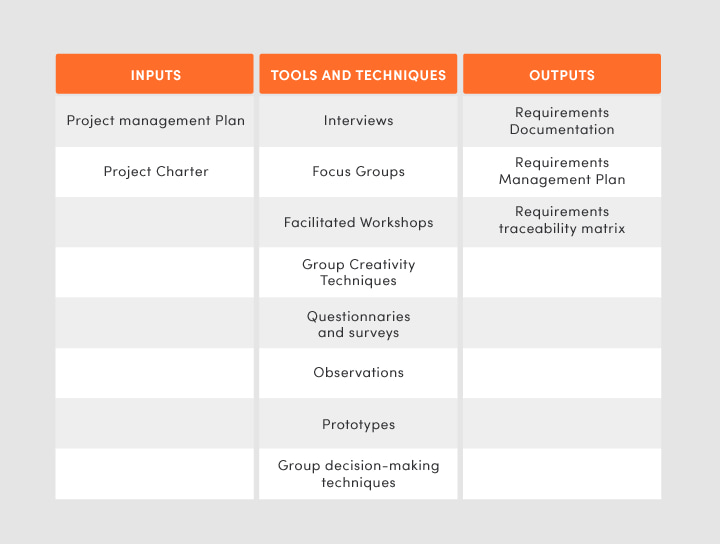If you have the uphill task of overseeing a firm or company project, you know how confusing writing a project scope can be. The process is often so challenging that most managers opt not to write one or even doctor one hurriedly.
However, undermining your project scope is always a recipe for failure. Most projects without a proper scope take up too many resources and time. Therefore, it is in your best interests to roll up your sleeves and write out your project scope.
In this article, you will get step-by-step advice on how to get the project scope done and some valuable tips to make sure it is well detailed.
Moreover, managers who are either too busy to set aside all that time to prepare a project scope or too overwhelmed by the process can turn to Selleo for help with getting their project scope done by experienced professionals.

What is a Project Scope
The project scope refers to the complete list of features or deliverables. These deliverables are created using the requirements of the project. According to Selleo, "a project scope is the job that needs to be done to provide a service, product, or result with the stated functions and features."
In simple terms, the project scope is just a way of describing what you have agreed to work on. It demonstrates the project's limitations and restrictions.
Project scope management involves three steps, which are discussed below.
- Planning
Planning involves an attempt to picture and specify the type of work you want.
- Controlling
This step of monitoring and controlling involves scope creep, documenting, tracking, and approving or disapproving any project modifications.
- Closing
The closing process entails an assessment of the pre-established project deliverables and a comparison of the original plan's outcome.
Let’s break this down; having a project scope is not enough. The end game is to have clear and concise scope statements that ensure your clients understand exactly what they are buying into from the onset. Your scope should be tailored to meet each client's demands and budget.
This article intricately demonstrates how to adjust your scope definition to accommodate different clients while maintaining its integrity and detail.
Since the nature and scale of the software project that you want to outsource influence how successfully you can specify the scope, it will affect:
- The method of scope management.
- The extent to which you can accurately approximate the workload, schedule, and budget from the start.
- The method of payment you could use while outsourcing.
- The procedure/approach for software development that you should use.
- Role and level of engagement in the development process of your in-house team.
- The vendor group that you should pick to design your software solution.
- The extent of customer or user participation required.
- The level of cooperation necessary to complete a project successfully.
As a result, each project presents unique issues requiring customized solutions appropriate for the project size and type. If you don't account for these variations, you will substantially limit your chances of successfully outsourcing.
In this post, we'll go over some crucial ideas and tactics for identifying the ideal scope statements for your project and the processes to follow and plenty of project scope statement examples to utilize in your project.
What is a Project Scope Statement?
A project statement outlines the work that the project manager should do and its parameters.
The scope statement specifies what is included and excluded from the project. More precisely put, the scope statements define the following:
- What exactly is being delivered (or in scope)?
- What isn't being provided (or out of scope)?
- Assumptions that help you understand the deliverables.
- To provide clarification needed on those mentioned above.
Scope statements are often used to define specific deliverables, but they can also describe individual components in conjunction with a statement of work.
Project scope statements are typically contained in a Statement of Work (SoW). However, they can also offer details for an estimate on their own.
To help you process how to structure your project scope statements, we will insert a few examples of scope statements below to show you how to incorporate these tips into your work:
- What is the project? Why is it taking place, and what will it achieve? (overview)
- Who has the last say (governance)?
- How will the project be finished (approach, stages, and tasks)?
- What will be manufactured? (deliverables)?
- When (timeline + milestones) will it be delivered?
- How much will it cost (estimate + payment plan)?
- What's included and what's not (assumptions)?
During your interactions, clients might use other names to refer to the project's scope. These alternative words include proposals, contracts, SoWs, or Statements of Work. It is to your advantage if you understand what the client wants in such situations and can deliver the project's parameters.
A well-written project statement is crucial in your dealings and may often be the difference between a successful project and a failed one. You might think we're making too big a claim, but a great project statement clearly defines the grey areas so that each party knows precisely what is included and what is not, leaving no room for assumptions or unmet expectations.
Defining the scope helps you avoid disappointing clients who may withhold payments or even sue your firm! It also enables you to prevent scope creep in your projects. Understanding how to define your scope brings us to the next part of this article, where we explain scope creep.
What is a Scope Creep?

Scope creep occurs when project deliverables surpass the scope of the project. Assume you're working on a product launch and haven't written a project scope statement yet. A stakeholder adds a press release to the project's deliverables halfway through. A separate stakeholder adds a blog post promoting the new product a few days later. This additional labour, which your project team was not anticipating or prepared for, might cause undue stress or even delays in your project's intended deliverables.
When your project suffers from scope creep, you'll find yourself working on duties you weren't expecting at the start. Project delays, overwork, and low-quality outputs are all possible outcomes.
The easiest method to avoid scope creep is to write a good project scope statement early in the process and discuss it with relevant stakeholders. That way, everyone is clear on what your project covers and what it doesn't.
Why is Scope Crucial for the Success of Your Project?
The importance of scope goes deeper than project management, it also translates into better economical results and revenues. A solid understanding of the project goals is a critical part of your project scope. The next section explains the importance of defining scope early in your project.
Benefits of defining the project scope early:
Defining the scope of your project is an integral part of project planning. Your project might distort and grow beyond your team's capacity to execute it if you don't have an explicit scope declaration, creating delays or burnout. Your project scope allows you to see your project through its lifespan and ensure that your final goals are attainable. Determining the scope of your project helps you to:
- Ascertain that all project stakeholders are fully informed of the project's limits.
- Manage the expectations of stakeholders and ensure they are on board.
- Reduce the project's risk.
- Appropriate resource planning and budgeting.
- Align the project with its primary goals.
- Keep scope creep at bay.
- Create a procedure for change requests (for complex projects)
Assuming your main objective focuses more on making profits than products, the scope is the most significant influencer of the economic outcome of your project. Ultimately, it decides the value your clients will receive and, as a result, the income you will make from your software-enabled venture or product. On the other hand, it will increase costs that will affect the bottom line, notably product development expenditures and maintenance and support charges. Because scope involves your project timeline, don't forget to include the cost of delay or the income you'll lose if you postpone your product's launch. If you launch it too late, your target clients may have already bought solutions offered by your rivals. Although the delay cost is often difficult to see, it is usually more critical than the actual expenses you incur when paying in cash.

How a Failed Project Scope Influences Your Business
Failing to control scope with the financial consequences in mind frequently results in:
- Producing goods that aren't market-fit – and delays and revenue loss in the worst-case scenario.
- Overruns in the budget
- Significant maintenance expenses.
- Meltdown in motivation.
Conversely, if you properly control your project scope, you will be far more likely to generate a lucrative product that sells enough to cover your expenditures. Some argue that saying it is easier than doing it. They understand the importance of the task but lack the motivation to carry it out. Others make a conscious, sincere, and continuous effort to do things well, and with luck, few succeed.
Scope of Work Tools
You can choose several options as your work tools; a good strategy is to use tools that your audience quickly understands and relates to. When picking your scope of work tools, it is necessary to understand that reading is way more difficult than seeing anything. Consequently, ensure you include a range of images and visual illustrations to compliment the task when creating a scope of work document. It will be much easier for the entire team to understand. Using visual aids while communicating with coworkers, bosses, and other departments can assist people recall the information. Not only that, but the impact on such teams is amplified, despite the fact that you all appear to be working from the same shared core image. This not only motivates everyone to engage in your project but also to give fresh and innovative ideas. It is to your advantage to start with visual illustration the next time you're trying to figure out how to get everyone to buy into your idea. It can help keep all stakeholders on the same page and moving together toward a common goal.
Google Drive- allows you to collaborate on documents
It encourages group cooperation to stream information quickly and effectively and to store all of one's thoughts in one place. As needed, groups can work on different pages or documents.
Apart from document storage, it also works with Google Docs (collaborative editing with a whiteboard and assigning tasks through comments), Google Slides (for presentations and especially for commenting on visual demonstrations), and Google Sheets (useful for arranging more extensive informational collections and fast mockups, such as information tables).
This tool excels at bringing people's work together and keeping them focused by collaborating and staying alert to any changes throughout the assignment.
Balsamiq-Wireframing made simple
Balsamiq Wireframes is a UI wireframing tool that mimics the feeling of sketching on a whiteboard or scratchpad but on a computer.
It also integrates with Google Drive, so you won't need to remember another login and password; sharing works just like any other Google Drive document and allows you to collaborate and co-edit projects in real-time.
Thanks to tight integrations with Google Docs, Spreadsheets, and Slides, your wireframes will be ready whenever you require them.
If you want more advanced features, try adopting Figma, which assists organizations in creating, testing, and executing better plans from start to finish. It also works with tagging frameworks and our upcoming applications.
How to Write a Project Scope

By this time, you have grasped what project scope is and what it means. The real challenge now lies in actually writing a project scope document. First off, your first scope definition should be thorough, explicit, and consistent. Both functional and non-functional requirements are provided in this project type, and scope change management will not be a significant difficulty. As a result, the vendor will be able to evaluate the workload before beginning implementation precisely, and you can expect them to agree to a fixed-price contract. Similarly, their timetable estimations should be accurate, and they'd have to have a definite reason to deviate from them.
As daunting a task as it may look, we are here to help you by giving you relevant tips. First off, you need to break the process into steps; we'll break it into five phases and discuss each step systematically and in detail.
Step 1: Define your Project Deliverables.
Project deliverables refer to all intangible and tangible results submitted within the scope of your project.
The project deliverables are the initial step of establishing your project scope. You have to be very specific about what you intend to accomplish with your task. A recommended tip is to apply the SMART rule to establish your project objectives:
- Specific (the project scope shows precisely what you should achieve with the project)
- Measurable (the goal is measurable, not vague)
- Achievable (it is reasonable, and the team can realize it)
- Realistic (it is achievable relatively quickly without overrunning the budget)
- Timely (it is feasible within the allocated time frame)
Goal-setting advice
Goal-setting is critical since it is the pacesetter for the remainder of your project's scope. Below are a few techniques to ensure you're getting the correct objectives.
- Be adaptable: Throughout a project, goals may vary or change entirely, and that's fine.
- Everyone should be involved: Objectives should not be established by a single person; all the stakeholders should participate and contribute their perspectives, which can help you incorporate overlooked items.
Step 2: Identify the Project Constraints
Project constraints are the limiting factors that can affect the project's quality, delivery, and success.
The next stage in good project planning is to identify potential stumbling blocks. What may jeopardize the budget of your project? What may cause significant delays?
Tips for identifying possible roadblocks: Obstacles are challenging to forecast, but you probably already know the challenges you will likely deal with within the project, so start there.
Step 3: Identify the Project Acceptance Criteria and Project Exclusion
The project acceptance criteria are fundamental conditions and performance requirements that must be satisfied before the project deliverables are approved. They specify the circumstances your team must fulfil for the user to accept the project's final result.
It would be best to understand what the client expects from you regarding quality, timeline, and the minimum threshold you must meet for your project to be accepted.
Project exclusion defines the description of things, tasks, or work beyond the project's scope. Identifying the excluded items is important to ensure you don't waste unnecessary resources on functions not relevant to your project.
On the same note, you should calculate and outline the comprehensive resources you will need to complete the project beforehand. Each task should be allocated its own resources, whether personnel, time, or funding.
How much money will your project take up? What are the materials needed? How many hours will be required to finish the project? You should thoroughly address these questions. You should do a lot of research and come up with precise estimates, as even informed assumptions always result in gross cost overruns that can derail the whole project.
Tips for identifying required resources
An accurate resource accounting ensures that every person involved has access to the tools needed to ensure the project is on track; therefore, this is a critical stage.
- Be thorough: Even minor expenses can mount up, so make a list of everything you can come up with that your project will require to be successful.
- Collaborate with other stakeholders: Share the list you generated with other project stakeholders to get their feedback and see if you've missed anything.
Step 4: Create a timeline with milestones
Now that you have already established the objectives, resources, and barriers, you may put up a provisional timeline for executing the project. It is crucial to set aside specific milestones for everyone to keep track of the project's development.
Tips for putting together a milestone schedule
Creating milestones is a crucial component of putting together the project scope. Once you've done that, you're virtually done, and all you have left to worry about is the plan scope control.
- Assign dates to every milestone: Merely having milestones is not enough; you also need to assign dates to each; otherwise, your tasks will lack a feeling of importance, and you'll risk missing the deadline.
- Have a contingency plan in place: If you don't achieve a milestone, you'll have a strategy for getting to the next one on time.
Step 5: Make a list of the people that are involved

Now that the objectives of your project have been outlined, you should compile a list of everyone involved. Anyone concerned or interested in the project is called a "stakeholder." They are typically the chief executive officer, investors, the chief financial officer, and the construction manager in the case of a construction firm.
List all the people who should be kept informed about this project and who have a vital role in completing it.
List of Stakeholders’ Suggestions
It's critical to maintain an extensive list of stakeholders since excluding someone might have severe consequences for the project if activities aren't accomplished due to their absence.
- Go through the milestones: Going over every component of the project scope set up so far is a fantastic method to identify stakeholders. Consider who is accountable for completing each milestone, gaining each resource, and overcoming each stumbling block. This inclusivity will ensure that you do not neglect anyone.
- Assign stakeholders to various aspects of the plan: By giving names to particular scope items like resources, milestones and tasks, it becomes apparent what everyone's roles are, making the project operate more smoothly.
If you are still feeling confused by now, don’t panic. We'll break it down even further by showing you what your template should probably look like now.
Template
Project Title
Introduction
The project's high-level summary is provided in the introduction.
Scope of the Project
Declare the project's scope. This section should detail what the project includes and excludes. This declaration will allow the project stakeholders to understand what the project consists of and clarify any confusion.
Deliverables of the Project
List the project's expected deliverables.
Acceptance Criteria for Projects
Define the conditions for acceptance. What goals will be achieved, and how will success be determined?
Exclusions from the Project
The things not covered by the project scope.
Project Limitations
Provide any project restrictions, such as deadlines, staffing or equipment limits, financial or budgetary constraints, or technological constraints.
This framework can help you start.
Project Scope Management Process and Tips
The scope isn't the first thing to consider when it comes to scope management. Scope management is broken down into five phases. It's ideal to have a decent notion of your project before starting.
Your client will want to know what methods you'll employ and how you'll carry out your job. There's a distinction to be made here between that and your project plan.

Efficient project scope management necessitates good communication to guarantee that team members and stakeholders understand your project's scope and implementation plan.
Scope management may help a project prevent problems such as an inflated scope or an unrealistic requirements list. The project scope determines what might be withdrawn or added as your project progresses. Scope management creates control methods to handle issues that can cause changes during the lifecycle of a project.
It is difficult to predict the cost and duration without first defining its scope. The scope may vary at times owing to poor communication.
Project scope management involves the six steps listed in the chart above, which are further discussed in this article.
1. Plan Scope Management
Plan Scope Management is the initial step in project scope management. It outlines the project's scope and how it will be developed, controlled and verified in the future.
It entails how the project scope will be implemented, validated, and regulated. It also covers how to prevent or deal with any scope creep, how to handle change requests, the process of making the scope statement, WBS, the escalation mechanism for any stakeholder disagreements on scope items, and the approval process of the deliverables.
The inputs, techniques and tools and output of the process shown below involve:

2. Collect Requirements
This process entails documenting the needs of everyone involved to achieve the project's objectives. Managers get the project's requirements from stakeholders using various strategies and technologies. The approach tries to cover all bases, resulting in a comprehensive set of project needs. If this approach is followed carefully and accurately, it can drastically reduce the chances of unwanted surprises even as your project nears completion.
The Inputs, Outputs and Tools & Techniques of the Collect Requirements phase are listed below.

3. Define Scope
This procedure includes writing a complete description of your project and its primary deliverables. The project scope outlines what the project is expected to accomplish and what it will not be able to deliver. The supporting documentation is examined to guarantee that your project will meet the listed objectives. The scope that emerges expresses the needs of the stakeholders and conveys project performance objectives.
The Inputs, Outputs, Tools & Techniques of the Define Scope Process are listed below.

4. Create a Work Breakdown Structure (WBS)
The Work Breakdown Structure is a crucial part of the process of scope management and is often missed by many project managers, resulting in erroneous planning. A WBS allows the team and manager of the project to break down a sophisticated scope statement into minor, more achievable work items. The resulting WBS must include a full list of the work packages necessary to complete the project.
The Create Work Breakdown Structure process's inputs, tools, techniques, and outputs are listed below.

5. Validate Scope
The Validate Scope process is mainly concerned with customer acceptability. Scope validation should always happen after every phase when the project client accepts all project deliverables in writing. Throughout the process, the consumer provides feedback about the job done.
The Validate Scope process's inputs, outputs, tools, and techniques are shown below.

6. Control Scope
Control scope is the final process group involved in the Project Scope Management. It entails monitoring the project status and managing any modifications to the project scope.
The Inputs, Outputs, Tools and Techniques of the Scope Control process are shown below.

This method involves evaluating different client needs or intentionally overlooking the project scope. To ensure your project is on track, managers constantly compare the project's work output to the project scope baseline. An integrated change control process handles all requested adjustments and proposed preventive or corrective measures.
Tips for Project Scope Management
Avoid ambiguity
Ambiguity in your scope may lead to wasted time and misunderstanding. Your scope should be well-defined and specific to prevent ambiguity.
Create Complete Outlook
An incomplete scope can result in slippages in your schedule, leading to unforeseen cost overruns. The scope should be as precise and comprehensive as possible to prevent this from happening. On the other hand, it is good to remember to avoid creating too extensive documentation.
React to Scope Changes
The leading cause of delays in delivery and projects that drag on for a long time is scope creep, arising from transient scopes. The project scope document should be completed, however, you need to react to project scope changes and plan to deliver the scope in iterations.
Prepare Scope Collaboratively
Failure to produce the scope collaboratively leads to misinterpretations in designs and requirements. Therefore, the scope should be distributed to all parties involved at every stage of the project scope definition process.
Summary
In conclusion, project managers are responsible for ensuring that the scope of work statement is thorough and complete. Yes, you're the one who's putting up a decent fight, and yes, the early stages of every project can be difficult, but they are a necessary evil for ensuring a smooth project and mitigating risk. We hope you find these tips helpful.
Executing the project scope management is not very hard. However, it needs time, patience, and effort. It is worth the money since good scope management helps you produce a well-defined scope and complete the project within your budget and on time.
If you need extra help, either through further consultation or by hiring a professional organization to assist you with working on your project scope, reach out to us. Selleo guarantees you a top-level project scope that will impress your clients, show professionalism, and ensure your projects run smoothly to completion.




